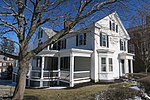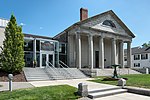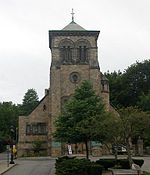Bartlett–Russell–Hedge House
Federal architecture in MassachusettsHouses completed in 1803Houses in Plymouth, MassachusettsHouses on the National Register of Historic Places in Plymouth County, MassachusettsNational Register of Historic Places in Plymouth County, Massachusetts

The Bartlett–Russell–Hedge House is a historic house in Plymouth, Massachusetts. Built in 1803, it is a fine local example of Federal architecture. It was listed on the National Register of Historic Places on April 30, 1976. It is presently part of a larger building that houses financial services businesses.
Excerpt from the Wikipedia article Bartlett–Russell–Hedge House (License: CC BY-SA 3.0, Authors, Images).Bartlett–Russell–Hedge House
Russell Street, Plymouth
Geographical coordinates (GPS) Address Nearby Places Show on map
Geographical coordinates (GPS)
| Latitude | Longitude |
|---|---|
| N 41.9575 ° | E -70.667222222222 ° |
Address
Russell Street 7
02360 Plymouth
Massachusetts, United States
Open on Google Maps











